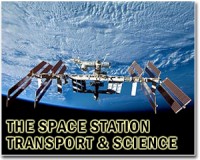 |
Washington (AFP) Feb 26, 2011 The US shuttle Discovery docked Saturday for its final visit at the orbiting International Space Station, where all five of the world's participating space agencies now have vehicles or equipment. "This is the first time all visiting vehicles have something represented," NASA mission control in Houston said, after the oldest and most heavily traveled US shuttle linked up with the space outpost 220 miles (350 kilometers) over western Australia. Japan's HTV vehicle, Russia's Progress and Soyuz craft, the European ATV-2 supply ship and the Canadian Dextre robot are all there, NASA said. Discovery arrived in spectacular fashion, with American commander Steve Lindsey executing a "rendezvous pitch maneuver," a one-degree-per-second rotational back flip, before mooring at the space lab at 2:14 pm (1914 GMT). The act of latching on caused quite a stir at the crowded lab. Discovery's orbiter and payload at launch weighed 121,843 kilograms (268,620 pounds), and the shuttle's arrival caused a rocking-the-boat motion on the orbiting station that took about 45 minutes to smooth out. "A hard mate between Discovery and the station was delayed to 3:04 pm ET (2004 GMT) while relative motions between the spacecraft dampened out," NASA said in Twitter message. The mass of the floating ISS is now a whopping 1.2 million pounds (540,000 kilograms), NASA said. The arrival of the six-member US crew brings the total staff on board the ISS to 12. Three Russians, one Italian and two Americans, including commander Scott Kelly, were already at the station when Discovery arrived. Kelly's twin brother Mark is also an astronaut and is scheduled to fly on the US shuttle Endeavour's last mission to the ISS in April. The Discovery crew is delivering the Permanent Multipurpose Module, with extra storage space and an area for experiments, as well as some spare parts and the Express Logistic Carrier, an external platform for large equipment. The shuttle has also brought the first humanoid robot to the ISS. The Robonaut 2, or R2, is a joint project of General Motors and NASA and will stay behind as a permanent resident of the space station when the shuttle leaves. A routine inspection of the shuttle heat shield found no apparent damage had been incurred during flight. The crews plan to work on transferring equipment and supplies on Sunday, then spacewalks are planned for Monday and Wednesday. The storage module is set to be installed on the Earth-facing side of the ISS on Tuesday. Discovery launched on its 11-day mission Thursday from Kennedy Space Center in Florida. The liftoff drew thousands of onlookers eager to catch a glimpse of one of the last three shuttle launches. "This is a pretty amazing time on board the space station," said Bill Gerstenmaier, NASA associate administrator for space operations, after Discovery blasted off. "It's probably unprecedented in the history of human spaceflight, the amount of activity to one single destination all focused around the same thing." The space shuttle program will end later this year, after Endeavour launches in April followed by Atlantis in June, leaving Russia's space capsules as the sole method of transport for astronauts heading to the ISS. It may be a decade before the American space program can create a new heavy lift rocket and crew capsule to bring astronauts to space again, NASA's chief technologist said.
Share This Article With Planet Earth
Related Links Station at NASA Station and More at Roscosmos S.P. Korolev RSC Energia Watch NASA TV via Space.TV Space Station News at Space-Travel.Com
 Discovery docks with International Space Station
Discovery docks with International Space StationWashington (AFP) Feb 26, 2011 The US space shuttle Discovery docked with the International Space Station on Saturday for a final time before it retires, carrying a new module and a robot to the orbiting research lab. NASA's oldest and most heavily traveled shuttle linked up with the ISS at 2:14 pm (1914 GMT) as the space outpost was 220 miles (350 kilometers) over western Australia, mission control in Houston said. D ... read more |
|
| The content herein, unless otherwise known to be public domain, are Copyright 1995-2010 - SpaceDaily. AFP and UPI Wire Stories are copyright Agence France-Presse and United Press International. ESA Portal Reports are copyright European Space Agency. All NASA sourced material is public domain. Additional copyrights may apply in whole or part to other bona fide parties. Advertising does not imply endorsement,agreement or approval of any opinions, statements or information provided by SpaceDaily on any Web page published or hosted by SpaceDaily. Privacy Statement |